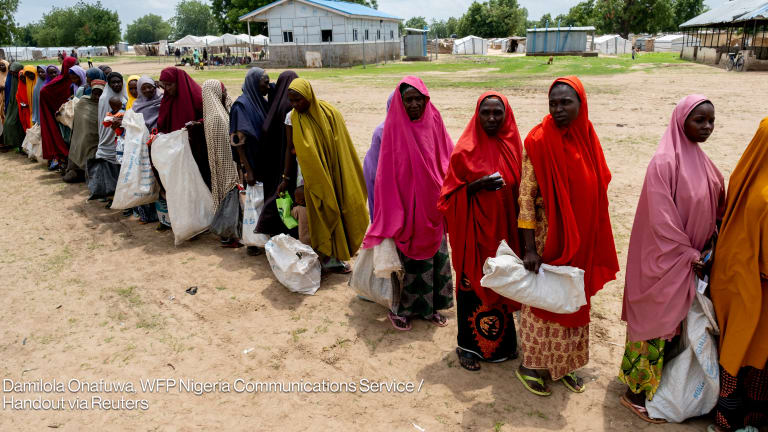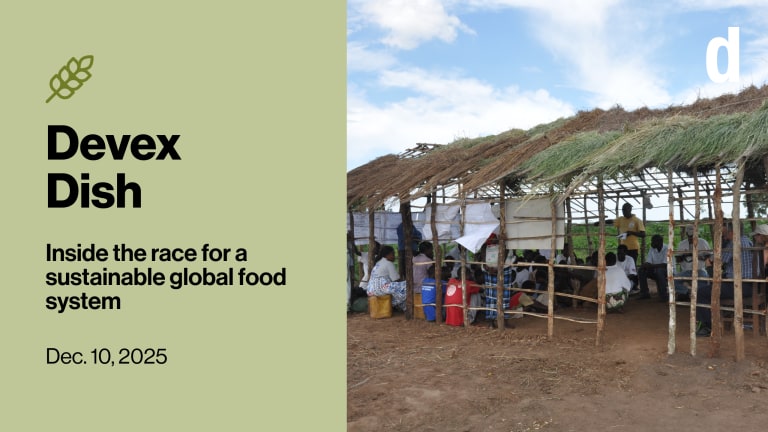
The risk of a seasonal drought every year is becoming increasingly likely — and worrisome — in the Horn of Africa. But is it so probable that humanitarian agencies should bet $140 million on it before it actually occurs?
It’s a challenging moral — as well as financial and logistical — question that major humanitarian agencies are considering as scientific forecasts become more accurate, while still containing some inherent uncertainty.
“Nowadays, we have the ability to forecast these types of [weather] events; we know how they will evolve. So the question really is: Why? What’s our justification for not getting ahead of it and providing funding earlier?” said Julia Wittig, a humanitarian affairs officer at the United Nations’ Central Emergency Response Fund.
“Overall, we think that this approach is not only feasible and the right thing to do, but it's also more efficient and it's more dignified,” Wittig continued.
Part of our Focus on: People and the Planet
This series explores how climate change and other planetary imbalances impact the rising trend of human inequality. Explore the potential solutions to eliminate inequality and support a healthy planet.
Nearly 260,000 people died of hunger in Somalia during a famine from 2010 through 2012, despite the availability of early warnings. As humanitarian needs rise around the world, acting faster and stronger on early warning systems could help prevent unnecessary deaths in these kinds of events, experts say.
CERF recently announced new “anticipatory action” funding allocations in Somalia and Ethiopia, totaling $40 million, to mitigate drought-induced food insecurity, which is expected to impact 15.6 million people in the coming months. In June 2020, U.N. Emergency Relief Coordinator Mark Lowcock announced CERF would provide up to $140 million in anticipatory financing over 18 months, marking a departure from CERF’s typical approach of quickly dispensing funding after a major emergency.
“They did a lot of work of trying to convince the donors of CERF to allocate this funding on this basis of uncertainty. This $140 million may be small compared to the total humanitarian budget, but for us, it is huge,” said Paris Kazis, program policy consultant at the World Food Programme, which has been increasing its early intervention efforts with support from anticipatory financing.
“We recognize this uncertainty, and it is part of the approach. It is up to the implementing agency to define what risk levels they are willing to take.”
— Paris Kazis, program policy consultant, World Food ProgrammeThis approach might also make financial sense. Constructing a new borehole in Somalia, for example, costs $75,000, while providing emergency water trucking over three months costs about $94,000, according to Wittig — with each method providing water to 3,000 people.
But while anticipatory humanitarian financing has risen over the last few years, donor funding remains relatively low. A lack of hard, long-term evidence showing the benefits of anticipatory financing contributes to donor reluctance, experts say.
Anecdotal evidence suggests that in Bangladesh, for example, giving cash to communities four days before an expected flood allows people to cover food costs for two weeks, according to Kazis. It also helps serve as a key early warning system encouraging people to prepare for the likely event and evacuate.
But projections of extreme weather events are not always accurate. In Nepal last year, one town was unexpectedly hit by flooding, diverging from the scientific projection of the areas that would be most affected. Sudden events such as typhoons and flash floods can be especially challenging to predict.
“We recognize this uncertainty, and it is part of the approach. It is up to the implementing agency to define what risk levels they are willing to take,” Kazis said.
The unpredictable nature of slow-onset and sudden environmental events is another factor that has discouraged donors.
“It’s a bit of a vicious circle, because you need money to generate the evidence, but you need evidence to generate money. At a certain point, we have to make a deal with donors [on scientific forecasts] — can we live with what we have so far? And then if that works, let’s invest more,” said Shirin Merola, a forecast-based financing coordinator for Africa at WFP.
WFP has been working on forecast-based financing since 2015, growing its portfolio from five to 16 countries during that time. Its anticipatory financing donors have increased from one in 2018 to five today, according to Merola and Kazis. The Food and Agriculture Organization has also expanded its anticipatory portfolio from approximately $1 million per year in 2016 to $5 million annually, according to Dunja Dujanovic, early warning team action leader at FAO.
“I think there is a collective realization that the current humanitarian system cannot provide for these rising needs but that we need mechanisms such as a anticipatory action to curb these things before they occur,” Dujanovic said.
More and more U.N. humanitarian agencies and groups such as the Red Cross are coordinating with experts like Andrew Kruczkiewicz, senior staff associate at Columbia University’s International Research Institute for Climate and Society. Satellite data and other scientific methods help Kruczkiewicz and his team understand and respond to tough questions about the probability of a flood occurring in a particular region in six months, for example.
“And that's different than just producing a flood map and emailing it to the World Food Programme. It's different than just saying, ‘Yeah, here are the different projections of heat waves in the next five years,’ and then tweeting it at the Red Cross,” Kruczkiewicz said.
Opinion: The rise of satellite imagery — what does it mean for aid and beyond?
Space technologies are everywhere, but Earth observation has some catching up to do if it’s to go mainstream. Now, this might just be happening, writes UNOSAT’s Einar Bjørgo.
Forecasts of environmental and weather events are becoming more accurate — but Kruczkiewicz still cautions humanitarian organizations to be skeptical when scientists or private research groups claim they can provide forecasts of “every minute for floods on every inch of the globe.”
“There are still limits to science,” Kruczkiewicz said.
Merola acknowledged this reality, noting that there is no “100% guarantee we are going to be right every time.” She also noted that while this method of humanitarian intervention is growing, it is not intended to replace traditional forms of emergency and humanitarian response.
“But there is always a bit of a trade-off between how much time I need as a humanitarian actor to be able to implement the type of activities I want to deliver on the ground but also how confident I am in the scale of a certain forecast and to be in a situation where I don’t have any regrets,” Merola said.
This focus area, supported by the U.N. Development Programme, explores how climate change and other planetary imbalances impact the rising trend of human inequality and vice versa. Visit the Focus on: People and the Planet page for more.









